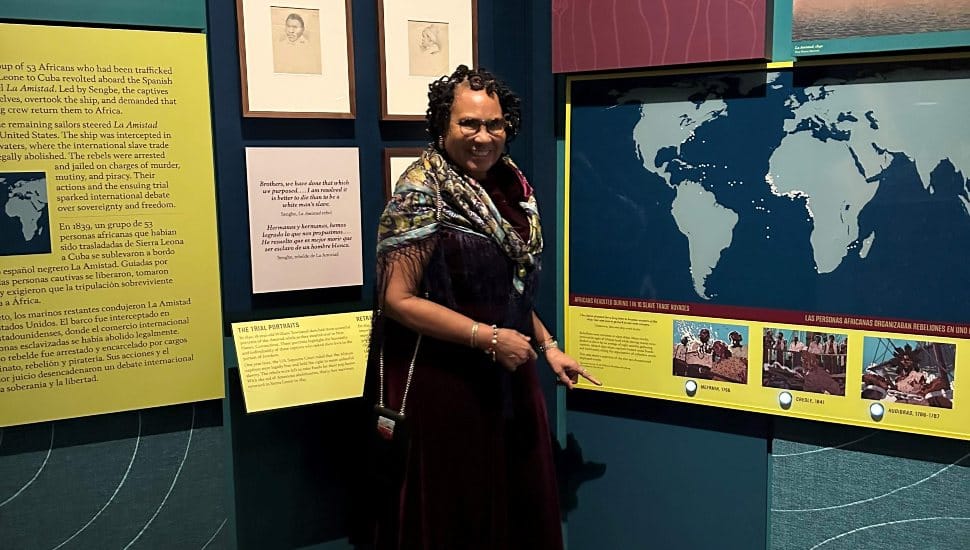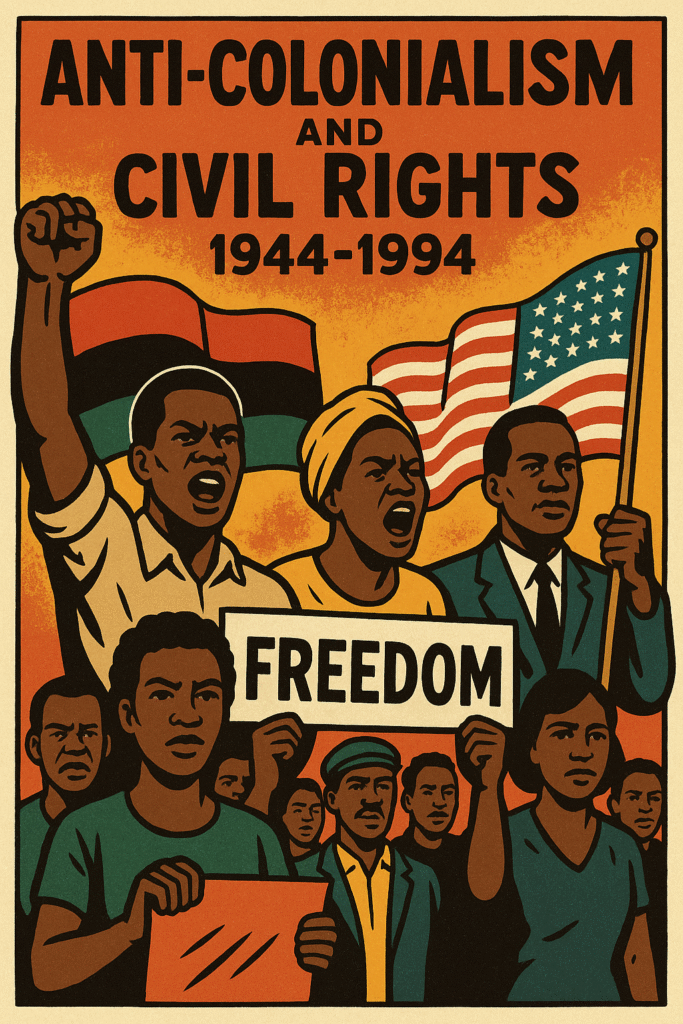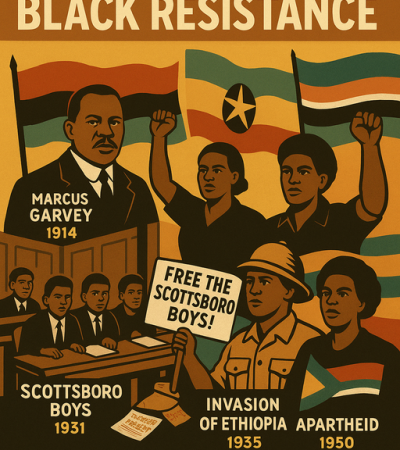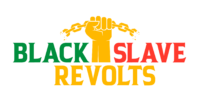MAP I: SLAVE REVOLTS
Narrative:

Some revolts involved Africans moving between plantations to gather support. The Civil War is now viewed as the second-largest slave revolt after Haiti, resulting in significant freedom for many. Women played critical roles in revolts; figures like Nanny in Jamaica and Solitude in 1802 were pivotal. Labor negotiations also prompted resistance in Jamaica’s Baptist War and the 1831 riots in Antigua. Free Blacks also rebelled, despite their nominal freedom, due to a lack of control over their labor and rights. Ultimately, these revolts contributed to the decline of the African trade and slavery.
Activity One: Questions
- K-3 Identify a person from a particular revolt and describe their role in the resistance. Looking at the ships on the slave revolt map, where did most ships begin their voyage? Draw the route the ships took to the two places they traveled to. If women were on the boat, what role did they play in the revolt?
- Identify slavery/enslavement; colonialism; triangular trade; neo-colonialism; revolutions; revolts; imperialism; empires.
- Compare two narratives of the same event; are they similar or different?
- Role of technology: Information was communicated through the oral tradition, speeches, newspapers, journals, radio, television, and social media. Identify one medium in a specific period and describe the impact of each of those modalities in interpreting historical events.
- Create a graph of the number of slave revolts in a century. In what year do you find the most revolts?
- Identify a particular revolt or act of resistance. Find a primary and secondary source that discusses the act. Contrast the two sources to reinforce what you have learned. Is there a difference between the primary and secondary sources, or are they different? Is there a common thread in sources? Do you detect any biases in the sources?
Activity Two: AP African American Studies Project: Analyzing Black Slave Revolts through Dr. Ife Williams' Multimodal Website
Project Title: Revolts in Resistance: Analyzing the Spirit of Freedom Across Centuries
Objective:
Students will explore the digital interactive map from Dr. Ife Williams’ Black Slave Revolts multimodal website and develop a comprehensive project synthesizing historical, geopolitical, and cultural analyses of African and African-descended slave revolts. The project will challenge students to think critically about these revolts’ causes, impacts, and broader implications and create a multimodal presentation to demonstrate their understanding.
Project Guidelines:
Students will:
- Select one documented revolt from the map to analyze in depth.
- Using the map and additional resources, research the conditions, leaders, outcomes, and geopolitical context of the revolt.
- Compare the chosen revolt to the Guadeloupean revolt led by Solitude, considering themes of freedom, resistance, and sacrifice.
- Create a multimodal project that includes:
- A written component (500–1,000 words) explaining the revolt’s historical significance, causes, consequences, and connection to global resistance movements.
- A visual representation of the revolt (e.g., an infographic, interactive timeline, or poster). If you prefer another format, please check with instructor.
- An audio or video element (e.g., a 3-minute podcast, spoken-word piece, or mini-documentary) reflecting on the revolt’s legacy and its relevance today.
Essential Questions to Address:
- What were the primary causes of the revolt?
- Who were the key figures involved, and what roles did they play?
- How did laws, conditions, or relationships within the enslaved community contribute to the revolt?
- What were the immediate and long-term consequences of the revolt?
- How did this revolt connect to or influence other acts of resistance globally?
- In what ways does the revolt reflect the principle of “live free or die”?
Activity Three: Who’s Who Crossword Puzzle
Activity Four: Hotspot Map! Locate Sapelo Island Resistance
Activity Five: Hotspot Map! Locate Two 1800 Revolts Led By Women
MAP II: ANTI-COLONIALISM AND CIVIL RIGHTS 1944-1994
Narrative:
Legal enslavement ended by the 1900s, but various loopholes, such as apprenticeship programs, continued to enforce labor exploitation. Gradual emancipation only freed children born after specific dates, leaving parents enslaved. The organized repression of people for free labor persisted, leading to labor movements where African descendants protested for rights. Governments often responded with repression, but these movements laid the groundwork for anti-colonial struggles, particularly in Africa and the Caribbean. By the 1930s, international communism expanded alongside labor unrest and anti-colonial movements. Leaders like William Patterson voiced the demands of African people globally. The 1944 transportation strike in Philadelphia in the US is highlighted to illustrate white backlash. Here, eight Black workers were promoted, prompting a strike of over 1,000 whites, precipitating federal intervention for Blacks during WWII. In Trinidad, attempts to raise salaries for workers faced government fines, highlighting institutionalized discrimination. Segregation in America influenced policies in places like Bermuda and culminated in apartheid in South Africa by 1948. Movements to end segregation, secure employment, and safeguard voting rights erupted. The Civil Rights Movement included diverse protest tactics, although some incidents involved armed resistance. After Martin Luther King’s assassination, over 100 riots erupted in America in a single year. From the 1950s to the 1990s, African nations fought for independence, some achieving it through negotiation and others through armed struggle, as seen in Zimbabwe, Mozambique, and Angola. Cultural identity played a significant role, as leaders like Amilcar Cabral inspired people to engage in revolutionary movements.

Activity One: Questions
- Identify Segregation, boycotts, sit-ins, freedom rides, the Black Panther Party, the Student Nonviolent Coordinating Committee, the Southern Christian Leadership Conference (SCLC), the Congress of Racial Equality (CORE), Deacons for Defense, Black Power, and integration.
- Contrast two sources describing the same event, primary and secondary. Give two similarities and differences.
- Role of technology: Information was communicated through the oral tradition, speeches, newspapers, journals, radio, television, and social media. Identify one medium in a specific period and describe the impact of each of those modalities in interpreting historical events.
- Identify two different civil rights movements in two distinct regions, compare, describe, and identify any similarities or differences.
- Identify one anti-colonial revolution in Africa and give a one-paragraph description.
- Newspapers have been a significant source of information for activists, such as Ida B. Wells and her reporting on lynching. Using newspapers as a primary source, research one newspaper in America, Europe, Africa, or Latin America and find one story of resistance.
- Identify one Civil Rights Movement in the United States and the local government’s response to the protest.
- What kind of historical material do you need to understand acts of resistance?
- How did the African and African American experience in WWII connect to their decisions to protest, for example, being denied access to the GI bill? Also, look at Ghana.
- Identify a particular revolt or act of resistance. Find a primary and secondary source that discusses the act. Contrast the two sources to reinforce what you have learned. Is there a difference between the primary and secondary sources, or are they different? Is there a common thread in sources? Do you detect any biases in the sources?
- Find an article on contemporary resistance anywhere in the world. Is that event connected to any information you learned from the map?
- Compare the similarities of the Black Power Movement in two different regions.
- France, Spain, Portugal, Belgium, Denmark, America, and Britain were known as “metropole countries,” as they had colonies worldwide. In each one of their colonial holdings, people were protesting. Select one metropole country and one colony and describe their relationship.
- Go online and locate an interview with a person involved in the Civil Rights Movement or Anti-colonial Movement, one of the markers on the map. Then, give a summary of their experience.
- Describe one event that occurred in Delaware during the Civil Rights Movement:
- Identify one woman in the Civil Rights or Anti-colonial movement and describe their role.
- Identify one anti-colonial movement and describe how leaders mobilized the people to revolt.
Activity Two: Map Hotspot-Locate Two Protests Led By Youth
Activity Three: Map Hotspot-Locate The Mau Mau Revolt
Activity Four: Map Hotspot: Locate Two Revolutionary Movements Where Women Were In Battle
Activity Five: Map Hotspot-Locate Operation Breadbasket Boycott
Activity Six: Who’s Who Crossword Puzzle
BOTH MAPS COMPARE AND CONTRAST
Narrative:
Transnational movements are plotted, the first being Marcus Garvey in 1914, who had over 1,200 branches and 40 countries; in some countries, the branches are still active. We have the Scottsboro Boys in 1931 that ignited a galvanizing campaign where seven Black men and one Black boy was accused of raping two white women. It was the Communist Party that played a significant role in disseminating information globally. Then we have the invasion of Italy of Ethiopia in 1935, where Black men in America wanted to sign up to go over there and fight on the side of the Ethiopians, and were denied. Yet, whites could go and assist the Italians. The anti-apartheid movement began in South Africa in 1950, lasted over 40 years, and was worldwide. The Black Power movement was the most resisted by the West, and was the most impressive, going to the far corners of the earth.

Activity One: Questions
- Identify one country where slave revolts occurred. Were there any forms of resistance during the anti-colonial and Civil Rights era?
- How are the two maps related? What is the basic theme in both maps?
- Create a timeline of slave revolts and resistance movements in one region.
- Is there a connection between the slave revolts and the civil rights movement in one region, especially Trinidad and Tobago?
- Both maps have several animations. Identify one or use one from the web slider on the home page. Contrast the information in the animation with the text and describe the resistance.
- Define Presentism; how would you use that concept to analyze data?
- Create a chart of three major global events, such as the Depression. Identify three acts of resistance within those periods.
- Are there relationships between the acts of resistance and international affairs?
